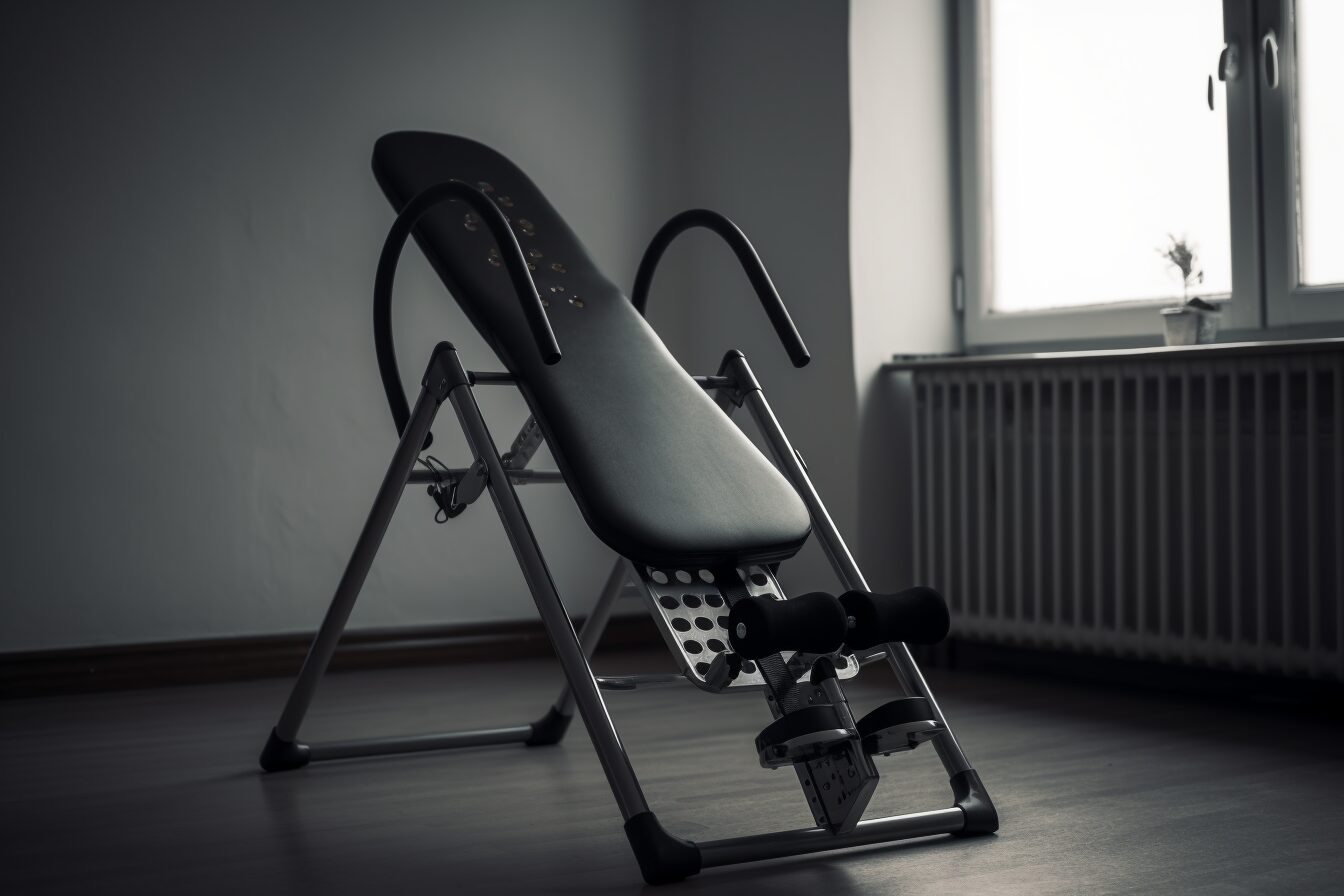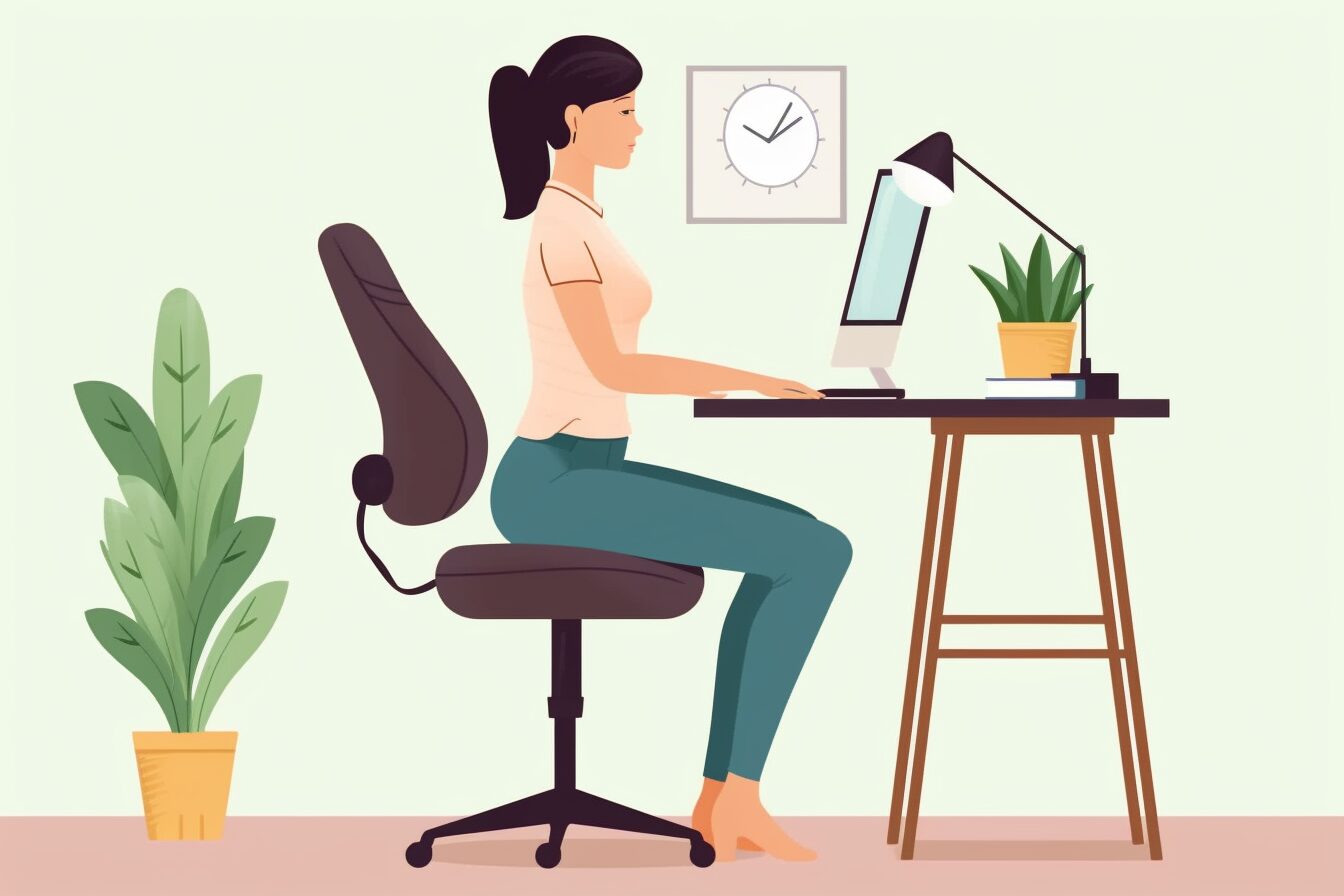Ease Your Spine: Back Decompression at Home Tips
Imagine finding relief from back pain without stepping foot outside your door. That's the promise of back decompression at home.
In this guide, we'll navigate through straightforward routines and adjustments in your daily life that can soothe pain and bolster the well-being of your spine, enabling you to do so without ever leaving the cozy confines of your living space. Exploring the use of common household objects such as cushions for bolstering your lower back, discerning when to consult experts, and getting acquainted with tools that can enrich your decompression practices will be part of your journey.
We'll also dive into essential dos and don'ts to ensure you practice safely. If you're navigating through the maze of chronic discomfort or simply aiming to keep your spine in tip-top shape, linger here for some nuggets of wisdom.
Table Of Contents:
- The Fundamentals of Spinal Decompression at Home
- At-Home Exercises for Spinal Decompression
- Incorporating Equipment into Your Decompression Routine
- Precautions Before Starting At-Home Decompression Therapy
- Lifestyle Adjustments for Optimal Spinal Health
- Success Stories with At-Home Spinal Decompressions
- Equipment-Free Techniques for Back Relief
- FAQs in Relation to Back Decompression at Home
- Conclusion
The Fundamentals of Spinal Decompression at Home

Spinal decompression therapy, a non-surgical method aimed at relieving back pain and other issues associated with spinal disc injuries, doesn't always require a visit to the clinic. With some knowledge and caution, you can perform spine decompression exercises in your living room.
What Conditions Benefit from Spinal Decompression?
If you're wrestling with lower back pain, sciatica, bulging discs, degenerative disc disease, or spinal stenosis - basically any condition that puts pressure on your nerves or reduces the space between vertebrae - spinal decompression might be just what the doctor ordered. This method softly widens the gap between your bones, easing the squeeze on nerves and enhancing circulation to mend.
Before you jump into spinal decompression, it's crucial to grasp its mechanics thoroughly. The process involves creating more space between vertebrae, which takes off pressure from compressed nerves – imagine giving those pinched nerves a breath of fresh air. This relief isn't only about easing current discomfort but also about preventing future flare-ups by addressing root causes like poor posture or muscle tension.
How Spinal Decompression Alleviates Back Pain
The science behind alleviating joint and nerve pressure through spine decompression reveals its magic in restoring normal function to affected areas. As spaces between bones increase thanks to carefully chosen stretches or movements – think elongation rather than compaction – circulation improves, bringing nutrients needed for tissue repair while flushing out inflammatory agents causing pain.
This mechanical unloading helps reposition bulged herniated discs away from sensitive neural tissues, reducing irritation significantly; thus providing not just temporary respite but paving the way towards lasting recovery, especially when combined with lifestyle adjustments targeting underlying issues contributing toward symptomatic expressions such as sedentary habits leading up to muscular imbalances around the spine region itself.
Key Takeaway:
Spinal decompression at home is a game-changer for anyone dealing with back pain or disc issues. It's all about creating space between your vertebrae, which eases nerve pressure and boosts healing blood flow. Dive into exercises carefully, aiming to stretch and elongate the spine – this not only soothes current pain but also wards off future problems by tackling root causes like bad posture.

Subscribe To Dr Mike's MVP Newsletter!
Exclusive content, interesting topics, real insights.

At-Home Exercises for Spinal Decompression
If you've been feeling the squeeze—literally—in your back, it's time to talk about decompressing that spine of yours without having to step foot outside your home. Good news: It’s easier than making a cup of coffee.
Prone Pillow Stretch
The prone pillow stretch is like telling your spine, "Hey, let's chill out for a bit." You just need a pillow and some floor space. Lie down on your stomach and place the pillow under your hips. This creates space in those spinal joints by gently stretching them apart. Imagine giving each vertebrae its little island—a break from being squished together all day.
Engaging in this activity, which demands no fancy gadgets, remarkably aids individuals in mitigating discomfort linked to slouching or spinal disc conditions.
Side Lying Decompression
Sometimes, what you need is as simple as lying on the side—but with a twist. Lie on one side with knees bent slightly toward the chest and keep arms stretched forward at shoulder width; this position encourages creating space within that crowded neighborhood known as our spine.
Bar Hang-Ups
Gymnasts make hanging look fun—and they’re onto something when it comes to spinal health too. Grabbing onto a chin-up bar (or any sturdy overhead structure) lets gravity do its thing, pulling you down while elongating the spine upward through weight hanging from arms completely straight—like dangling earrings that accentuate how tall someone stands standing upright next to them.
Incorporating Equipment into Your Decompression Routine:
Teeter Hang Ups Inversion Tables are fantastic tools if looking to go further in relieving pressure off those nerves.
Dr. Ho’s Spinal Decompression Belt can also add an extra layer of support during exercises.
Remember: Always check with a healthcare professional before starting new routines especially if dealing with joint pain or other specific conditions such as bulging discs or sciatica because every back story has its unique twists and turns needing a personalized care plan tailored just right.
Key Takeaway:
Feeling the squeeze in your back? Decompress at home with simple exercises like the prone pillow stretch, side lying decompression, and bar hang-ups. No need for fancy equipment, but tools like inversion tables can boost relief. Always chat with a healthcare pro before starting new routines.
Incorporating Equipment into Your Decompression Routine

When it comes to spinal decompression at home, adding the right equipment can be a game-changer. Let's explore two popular tools: inversion tables and back braces for stability.
Inversion Tables: Flipping Pain on Its Head
Utilizing an inversion table, you're suspended in an upside-down position, which leverages gravitational pull to mitigate spinal compression. It’s like turning the stress of your day upside-down—literally. These contraptions stretch your back, offering solace from sciatica or lumbar discomfort right in the comfort of your dwelling.
Interested in giving it a try? Check out Teeter Hang Ups for a trusted option.
But remember, while hanging around might sound fun, make sure this fits into your routine under guidance from a healthcare professional especially if you have conditions like high blood pressure or heart issues that could make inversion therapy risky.
Back Braces: Stability Where You Need It Most
If flipping upside down isn’t quite your style but you still want to support your spine effectively, consider trying a back brace designed specifically for spinal decompression. These nifty devices work by providing external support that helps reduce pressure on affected areas of the spine during activities or even just throughout the day.
A standout example is Dr.Ho's Spinal Decompression Belt, which not only offers support but also claims to enhance blood flow—a double win. While wearing one won't magically fix all back issues overnight, integrating it into daily life alongside exercises and stretches can contribute significantly towards managing symptoms and improving overall comfort levels.
Beyond gadgets and gizmos, remember that consistency with decompression exercises plays an essential role in finding long-term relief from back pain. Inversion tables and back braces are fantastic supplements to an already solid routine focused on creating space within the spine through gentle movement and targeted stretching.
Key Takeaway:
Adding inversion tables or back braces can seriously up your home decompression game. While the former uses gravity to ease spine pressure, the latter offers extra support during daily activities. But don't forget, consistency with exercises is key for long-term relief.
Precautions Before Starting At-Home Decompression Therapy
Before you dive headfirst into at-home spinal decompression therapy, there are some important safety nets and checkpoints to consider. It's vital to make sure these exercises are right for you before getting started.
Consult Healthcare Professional
The first step on your journey should always be a consultation with a healthcare professional. This isn't just about covering bases; it's about understanding the unique needs and conditions of your body. Spinal issues can range from mildly annoying to severely debilitating, and what works for one might not work for another. A healthcare provider can give tailored advice that ensures your home therapy aids rather than aggravates your condition.
A professional assessment is particularly vital if you have pre-existing conditions like herniated discs or spinal stenosis which could influence the type of decompression exercises suited to you.
When To Avoid At-Home Therapy
Certain individuals should steer clear of at-home decompression methods altogether. If you're pregnant, have recently undergone surgery, or suffer from specific medical conditions such as osteoporosis, severe scoliosis, or vertebral fractures—decompression therapy without direct supervision could do more harm than good.
This guidance isn't meant to scare but rather ensure that when done right—and safely—spinal decompression can offer significant relief without unnecessary risks.
Lifestyle Considerations And Modifications
Chatting with experts and recognizing when to sidestep specific treatments, tweaking one's way of living is pivotal in fully reaping the rewards spinal decompression offers from the comfort of your home. Adopting habits that promote spine health—such as maintaining moderate weight through diet changes and regular exercise—is key.
Poor posture often contributes significantly to back pain; thus focusing on improving how we sit, stand, and sleep can alleviate undue stress on our spines over time More info here.
Key Takeaway:
Always chat with a healthcare pro before starting at-home spinal decompression. They'll make sure the exercises fit your specific needs and don't hurt you, especially if you've got conditions like herniated discs or spinal stenosis. Plus, some folks—like those pregnant or recently operated on—should skip these methods for safety.
Lifestyle Adjustments for Optimal Spinal Health

The Role of Good Posture in Preventing Back Issues
Maintaining moderate weight and incorporating regular movement into your daily routine are not just good advice for overall health—they're crucial for keeping your spine happy. Think about it: Every pound adds pressure to your back, and without enough movement, muscles around the spine weaken. This combo is like a one-two punch to your spinal health.
Good posture isn't just about looking confident. It's about aligning your body so that the spine supports itself with minimal stress. Whether you're standing or sitting, insights show that correct posture can alleviate unnecessary strain on your backbone.
It's essentially about crafting our environments, be it at home or work, to embrace rather than contest the natural posture of our bodies. Proper chair height, monitor positioning, and even the way we hold our phones can make a world of difference in preventing postural issues before they start.
If you're intrigued by the idea of nurturing a robust spine via alterations in your daily habits or seek tailored advice on ergonomic arrangements, both Morley Chiropractic Clinic and Complete Chiro Care stand as excellent repositories of knowledge.
With these adjustments—focusing on weight management, staying active, practicing good posture throughout the day, and optimizing our environments—we set ourselves up not only for a healthier back but also for an overall better quality of life.
Incorporating an inversion table into your routine can also amplify benefits by allowing gravity to aid in the decompression process. By suspending yourself upside down or at an angle where your head is lower than your heart, you increase blood flow back towards upper body organs while giving those hard-working spinal discs some much-needed relief. But remember, safety first: it's always wise to warm up properly before diving into these more demanding poses.
To really target specific areas such as the left knee or engage in hamstring stretches that promote flexibility alongside strength building is key too. For instance, adopting poses that stretch out this area while keeping attention on maintaining long breaths helps not only increases flexibility but also ensures ample oxygen supply which aids further in recovery processes post-exercise.
Success Stories with At-Home Spinal Decompressions
At-home spinal decompression has been a game-changer for many, turning tales of back pain into stories of relief and mobility. It's not just about the stretches; it’s about reclaiming life.
The journey often starts with simple exercises like the prayer stretch or overhead stretches that don't require any fancy equipment but can make a world of difference. Imagine being able to alleviate that nagging lower back pain through movements you can do while watching TV or taking a break from work.
Exploring further into this treatment, devices such as inversion tables have demonstrated encouraging outcomes. Websites such as ours... HB Chiropractic... are treasure troves of success stories where individuals have found significant relief from chronic conditions such as sciatica and degenerative disc disease using these methods.
What Conditions Benefit from Spinal Decompression?
The beauty behind spinal decompression lies in its versatility. Conditions ranging from bulging discs to spinal stenosis see marked improvement because this technique works by creating space between vertebrae, easing pressure on nerves.
This increased vertebral space is crucial for improving blood flow and reducing inflammation around affected areas—key factors in healing back issues without resorting to surgery.
Lifestyle Adjustments for Optimal Spinal Health
Beyond exercises, incorporating lifestyle changes plays an enormous role in preventing future spine problems. Standing upright with good posture might seem overly simplistic advice yet it holds power in maintaining spinal health over time.
Equipment-Free Techniques for Back Relief
Child's Pose: A gentle stretch focusing on relaxation and spine elongation.
If you've ever watched a yoga class in action, you're probably familiar with the Child's Pose. But don't let its simplicity fool you; this is a powerhouse move for decompressing your back. By gently stretching the muscles surrounding your spinal column, it helps create space between vertebrae that might be feeling a bit too cozy due to poor posture or long hours at the desk.
Start by sitting on your heels with knees shoulder-width apart, then lean forward until your forehead touches the floor, arms extended or by your sides—whichever feels best. Hold this pose while taking long breaths to maximize blood flow and further relax tight areas.
T-Spine Extensions: Targeting the thoracic spine for improved mobility.
The thoracic spine—or T-spine—is where most of us hold tension from bad habits like slouching over smartphones or computers all day (guilty as charged). To give this area some love, try T-Spine extensions using nothing but an imaginary chin-up bar.
Stand upright with feet hip-distance apart and imagine grabbing onto a bar overhead with elbows completely straight. Gently arch backward from your upper back (not lower.), aiming to look up at the ceiling while keeping your glutes engaged so as not to stress lower back muscles unnecessarily.
This easy exercise doesn’t just alleviate symptoms; it actively works against joint hypomobility caused by our modern lifestyles.
Finding equipment-free techniques can sometimes feel like searching for a needle in a haystack, but here are some great options that actually work.
Remember, starting any new exercise routine should come after getting a green light from a healthcare professional, especially if existing conditions like herniated discs or sciatica are part of your health landscape.
Each technique we've shared here aims to relieve increased pressure on joints and nerves without needing special gadgets—just gravity and body weight doing their thing. Whether standing upright reaching towards an imaginary ceiling holding those T-spine extensions or sinking into peaceful Child’s Pose stretches—the goal remains clear: alleviating discomfort through creating space within our bodies.
So next time back pain tries crashing your party uninvited? Show it who's boss with these simple yet effective maneuvers designed specifically to help people regain control over their own well-being—all without stepping foot inside an equipment-filled gym.
Key Takeaway:
Dive into equipment-free back relief with techniques like the Child's Pose and T-Spine Extensions. These simple moves help create space in your spine, improving posture and alleviating discomfort—all from the comfort of home.
FAQs in Relation to Back Decompression at Home
Is it OK to decompress your spine?
Absolutely. Spinal decompression can relieve pain, improve mobility, and foster better spinal health when done correctly.
How do you sleep to decompress your spine?
Sleep on your back with a pillow under your knees or on your side with a pillow between them for optimal alignment.
How do I decompress my back in 30 seconds?
Lie flat, pull both knees to the chest gently. Hold for 30 seconds. It quickly relieves tension in the lower back.
How can I decompress my nerves at home?
Gentle stretches like neck tilts and shoulder rolls help. For sciatica, try the piriformis stretch. Move slowly; don't force it.
Conclusion
Easing into back decompression exercises at your place could significantly transform the battle against back discomfort. Creating room, alleviating stress, and delivering solace in crucial areas embodies the essence of home back decompression.
You've learned the science behind spinal decompression and how simple exercises can make a big difference. Remember: gentle stretches, like the prone pillow stretch or side-lying technique, are your friends.
Avoiding certain activities is just as important when conditions don't align. Listen to your body and know when to seek help from professionals.
And let's not forget about devices that aid in deeper decompression or lifestyle tweaks for long-term benefits. Every step taken is a step towards better spinal health.
In all this, back decompression at home stands out as an empowering tool. By dedicating time and effort, you're journeying towards a life with reduced discomfort and enhanced mobility.
18600 Main St STE 110, Huntington Beach, CA 92648

Subscribe To Dr Mike's MVP Newsletter.
Get In Touch
(714) 794-2171
Office Hours
Monday-Thursday:
7:00 am - 11:00 am, 2:00 pm - 6:00 pm
Friday: Closed
Saturday: By Appointment Only
Sunday: Closed

(714) 794-2171
Subscribe To Dr Mike's MVP Newsletter.
Office Hours
Monday-Thursday:
7:00 am - 11:00 am, 2:00 pm - 6:00 pm
Friday: Closed
Saturday: By Appointment Only
Sunday: Closed
18600 Main St STE 110, Huntington Beach, CA 92648
Huntington Beach Chiropractic | Copyright ©2025 | Website by iTech Valet
